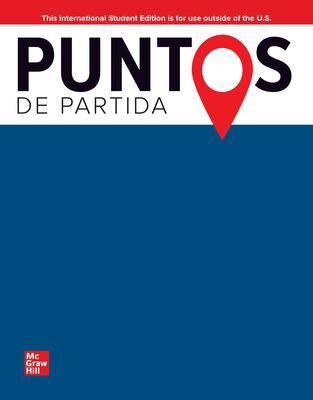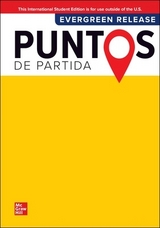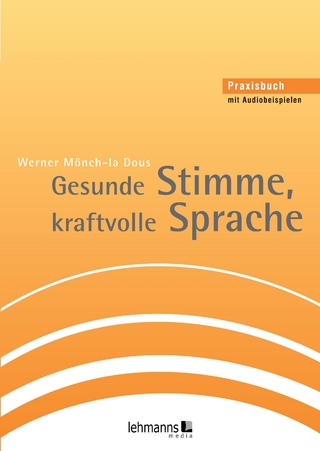
ISE Puntos (Student Edition)
McGraw-Hill Education (Verlag)
978-1-260-57528-6 (ISBN)
- Titel z.Zt. nicht lieferbar
- Versandkostenfrei innerhalb Deutschlands
- Auch auf Rechnung
- Verfügbarkeit in der Filiale vor Ort prüfen
- Artikel merken
Success in the language classroom requires so much more than just a text. In any language-learning setting, students require numerous and various opportunities to read, write, hear, and speak.
Puntos de partida sets the standard for Spanish-language teaching. An innovative program that has been continuously refined for today’s classroom, Puntos delivers proven pedagogy with clear and effective presentations, comprehensive teaching resources, and powerfully adaptive digital tools.
Now in its anniversary Tenth Edition, Puntos builds on the holistic, five-skills approach it pioneered. It’s the Puntos you know. It’s the Puntos of today.
Puntos hallmark features include:
Engaging and Immersive Digital Tools: Connect Spanish is the most powerful and flexible course management system available. Rooted in research on effective student learning practices, the platform integrates adaptive learning tools with dynamic, engaging language practice activities. McGraw-Hill’s LearnSmart provides each student with a personalized and adaptive learning experience based on individual needs. Connect Spanish also provides the instructor with both the ability and flexibility to pull from the robust set of content available in the platform and craft a unique learning path based on the goals of the course. With Practice Spanish: Study Abroad, the market’s first 3-D immersive language game designed exclusively by McGraw-Hill, Puntos brings the language to the students in a fun, engaging, and immersive gaming experience.Students “study abroad” virtually in Colombia where they will create their very own avatar, live with a host family, make new friends, and navigate a variety of real-world scenarios using their quickly developing Spanish language skills. The first and only analytics tool of its kind, Connect Insight is a series of visual data displays—each framed by an intuitive question—to provide instructors at-a-glance information regarding how your class is doing. Connect Insight provides analysis on five key insights, available at a moment’s notice from your Connect course.
A Comprehensive scope and sequence: The comprehensive scope and sequence allows instructors to choose what to cover throughout the course without having to supplement their own materials to fill gaps present in other texts.
Carefully arranged organization: the overall organization carefully progresses from formulaic expressions to vocabulary and grammar relevant to daily life and personal interests (studies, family, home,leisure activities), then goes on to prepare students for survival situations(ordering a meal, traveling), and finally branches out to broader themes(current events, social and environment issues). This forward progress is reinforced by a cyclical structure where vocabulary, grammar, and language functions are continuously reviewed and recycled.
Clear and effective vocabulary and grammar presentations: Puntos’ approach to vocabulary and grammar focuses on the acquisition of vocabulary during the early stages of language learning and then at the start of each chapter throughout the text.Grammar is introduced in thorough explanations, with careful attention given to skills development rather than grammatical knowledge alone. These explanations are now even more accessible to students, featuring conversational language, increased clarity,additional examples, and organization of complex, dense explanations into manageable chunks of concise grammar summary.
Integrated four-skills approach: Puntos carefully sequences activities, moving students from controlled to free-form tasks. In the tenth edition, this overall scaffolding is improved and introduced at the individual activity level.Starting with the very first activity fol
Thalia Dorwick has taught at Allegheny College, California State University (Sacramento), and Case Western Reserve University, where she received her Ph.D. in Spanish in 1973. She has been recognized as an Outstanding Foreign Language Teacher by the California Foreign Language Teachers Association. Dr. Dorwick is the coauthor of several textbooks and the author of several articles on language teaching issues. Ana María Pérez-Gironés is an adjunct Professor of Spanish at Wesleyan University, Middletown, Connecticut. She received a Licenciatura en Filología Anglogermánica from the Universidad de Sevilla in 1985, and her M.A. in General Linguistics from Cornell University in 1988. Her professional interests include second language acquisition and the integration of cultural competence and technology in language teaching
Capítulo 1 Ante todo
Vocabulary and Pronunciation
Primera parte
Saludos y expresiones de cortesía
El alfabeto español
Grammar
¿Cómo es usted? (Part 1)
Los números del 0 al 30; Hay
Los gustos y preferencias (Part 1)
¿Qué hora es?
Capítulo 2 En la universidad
Vocabulary and Pronunciation
En el salon de clase
Las materias
Grammar
Naming People, Places, Things, and Ideas (Part 1): Singular Nouns: Gender and Articles
Naming People, Places, Things, and Ideas (Part 2): Nouns and Articles: Plural Forms
Getting Information (Part 1): Asking Yes/No Questions
¿Qué hora es?
Cultura: Los Estados Unidos de América
Capítulo 3 La familia
Vocabulary and Pronunciation
La familia y los parientes
Los números del 31 a 100
Los adjectivos
Grammar
Describing: Adjectives: Gender, Number, and Position
Expressing to be: Present Tense of ser; Summary of Uses (Part 2)
Expressing Possession: Unstressed Possessive Adjectives (Part 1)
Expressing Actions: Present Tense of -er and -ir Verbs; Subject Pronouns (Part 2)
Cultura: México
Capítulo 4 De compras
Vocabulary and Pronunciation
De compras: La ropa
Los colores: ¿De qué color es?
Los números a partir del 100
Grammar
Pointing Out People and Things: Demonstrative Adjectives (Part 2) and Pronouns
Expressing Actions and States: Tener, venir, poder, preferir, querer; Some Idioms with tener
Expressing Destination and Future Actions: Ir; The Contraction al; Ir + a + Infinitive
Cultura: Guatemala y Honduras
Capítulo 5 En casa
Vocabulary and Pronunciation
Los muebles , los curators y otras partes de la casa
¿Qué día es hoy?
¿Cuándo?: Las preposiciones (Part 1)
Grammar
Expressing Actions: Hacer, oír, poner, salir, traer, ver
Expressing Actions: Present Tense of Stem-changing Verbs (Part 2)
Expressing -self/-selves: Reflexive Pronouns (Part 1)
Cultura: El Salvador y Nicaragua
Capítulo 6 Las estaciones y el tiempo
Vocabulary and Pronunciation
¿Qué tiempo hace hoy?
Los meses y las estaciones
¿Dónde está?: Las preposiciones (Part 2)
Grammar
¿Qué están haciendo?: Present Progressive: Estar + -ndo
¿Ser o estar?: Summary of the Uses of ser and estar
Describing: Comparisons
Cultura: Costa Rica
Capítulo 7 ¡A comer!
Vocabulary and Pronunciation
La comida y las comidas
¿Qué sabe Ud. y a quién conoce?
Grammar
Expressing what or who(m): Direct Objects: The Personal a; Direct Object Pronouns
Expressing Negation: Indefinite and Negative Words
Influencing Others: Commands (Part 1): Formal Commands
Cultura: Panamá
Capítulo 8 De viaje
Vocabulary and Pronunciation
De viaje
De vacaciones
Grammar
Expressing to who(m) or for who(m): Indirect Object Pronouns; Dar and decir
Expressing Likes and Dislikes: Gustar (Part 2)
Talking About the Past (Part 1): Preterite of Regular Verbs and of dar, hacer, ir, and ser
Cultura: La República Dominicana
Capítulo 9 Los días festivos
Vocabulary and Pronunciation
Una fiesta de cumpleaños para Javier
Las emociones y los estados afectivos
Grammar
Talking About the Past (Part 2): Irregular Preterites
Talking About the Past (Part 3): Preterite of Stem-changing Verbs
Avoiding Repetition: Expressing Direct and Indirect Object Pronouns Together
Cultura: Cuba
Capítulo 10 El tiempo libre
Vocabulary and Pronunciation
Los pasatiempos, diversions y aficiones
Los quehaceres domésticos
Grammar
Talking About the Past (Part 4): Descriptions and Habitual Actions in the Past: Imperfect of Regular and Irregular Verbs
Getting Information (Part 2): Summary of Interrogative Words
Expressing Extremes: Superlatives
Cultura: Puerto Rico
Capítulo 11 La salud
Vocabulary and Pronunciation
La salud y el bienestar
En el consultorio del médico
Grammar
Talking About the Past (Part 5): Using the Preterite and the Imperfect
Recognizing que, quien(es), lo que: Relative Pronouns
Expressing each other (Part 2): Reciprocal Actions with Reflexive Pronouns
Cultura: Venezuela
Capítulo 12 ¡Conestad@s!
Vocabulary and Pronunciation
La ciudad y el barrio
La tecnología
Grammar
Influencing Others (Part 2): Tú (Informal) Commands
Expressing Subjective Actions or States: Present Subjunctive (Part 1): An Introduction
Expressing Desires and Requests: Use of the Subjunctive (Part 2): Influence
Cultura: Colombia
Capítulo 13 El arte y la cultura
Vocabulary and Pronunciation
Los artes
Los ordinales
Grammar
Expressing Feelings: Use of the Subjunctive (Part 3): Emotion
Expressing Uncertainty: Use of the Subjunctive (Part 4): Doubt and Denial
Expressing Influence, Emotion, Doubt, and Denial: The Subjunctive (Part 5): A Summary
Cultura: El Ecuador y Bolivia
Capítulo 14 Las presiones de la vida moderna
Vocabulary and Pronunciation
Las presiones de la vida académica
¡Qué mala suerta!
Grammar
Telling How Long Something Has Been Happening or How Long Ago Something Happened: Hace… que: Another Use of hacer
Expressing Unplanned or Unexpected Events: Another Use of se
¿Por o para?: A Summary of Their Uses
Cultura: El Perú
Capítulo 15 La naturaleza y el medio ambiante
Vocabulary and Pronunciation
La ciudad y el campo
Los vehículos
Grammar
Más descripciones: Past Participle Used as an Adjective
¿Qué has hecho?: Perfect Forms: Present Perfect Indicative and Present Perfect Subjunctive
Cultura: La Argentina y El Uruguay
Capítulo 16 La vida social y afectiva
Vocabulary and Pronunciation
Las relaciones sentimentales
Las etapas de vida
Grammar
¿Hay alguien que… ? ¿Hay un lugar donde… ?: The Subjunctive (Part 6): The Subjunctive After Nonexisting and Indefinite Antecedents
Lo hago para que tú…: The Subjunctive (Part 7): The Subjunctive After Conjunctions of Purpose and Contingency
Cultura: El Paraguay
Capítulo 17 ¿Trabajar para vivir or vivir para trabajar?
Vocabulary and Pronunciation
Las profesiones y los oficios
El mundo laboral
Una cuestión de dinero
Grammar
Talking About the Future: Future Verb Forms
Expressing Future or Pending Actions: The Subjunctive (Part 8): The Subjunctive and Indicative After Conjunctions of Time
Cultura: Chile
Capítulo 18 La actualidad
Vocabulary and Pronunciation
Las noticias
El gobierno y la responsabilidad cívica
Grammar
Queríamos que todo el mundo votara: The Subjunctive (Part 9): The Past Subjunctive
Expressing What You Would Do: Conditional Verb Forms
Cultura: España
| Erscheinungsdatum | 27.01.2020 |
|---|---|
| Zusatzinfo | 322 Illustrations |
| Verlagsort | OH |
| Sprache | englisch |
| Maße | 198 x 269 mm |
| Gewicht | 1204 g |
| Themenwelt | Schulbuch / Wörterbuch ► Wörterbuch / Fremdsprachen |
| Geisteswissenschaften ► Sprach- / Literaturwissenschaft ► Sprachwissenschaft | |
| ISBN-10 | 1-260-57528-4 / 1260575284 |
| ISBN-13 | 978-1-260-57528-6 / 9781260575286 |
| Zustand | Neuware |
| Haben Sie eine Frage zum Produkt? |
aus dem Bereich



